Kapverden |
|
|
|
| Übersicht – Contents: | |
Diese Seite ist Teil des Projektes
Kapverden |
|
|
|
| Übersicht – Contents: | |
Flagge – Flag: |
|
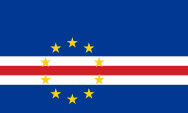 |
Nationalflagge – national flag, Seitenverhältnis – ratio = 3:5, Quelle/Source, nach by: Drawn by User:SKopp [Public domain], via Wikimedia Commons   |
historische Flaggen – historical Flags: |
|
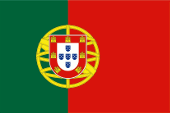 |
1911–1975, |
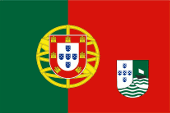 |
60-er Jahre 19. Jhd. / sixties of the 19th cent., |
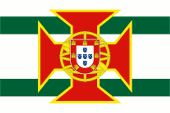 |
1935–1975, Flagge des Generalgouverneurs – flag of the Governor General, Seitenverhältnis – ratio = 2:3, Quelle/Source, nach by: Die Welt im bunten Flaggenbild  |
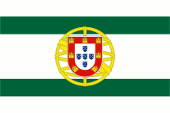 |
bis/to 1935, Flagge eines Oberkommissars – flag of a High Commissioner, Seitenverhältnis – ratio = 2:3, Quelle/Source, nach by: Flaggenbuch 1939 |
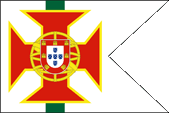 |
1935–1961, Flagge eines Distriktskommandanten – flag of a District Commandant, Seitenverhältnis – ratio = 2:3, Quelle/Source, nach by: nach by: Flaggenbuch 1939 |
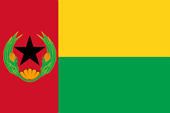 |
1975–1992, |
Bedeutung/Ursprung der Flagge – Meaning/Origin of the Flag: |
|
| Die
heutige Flagge der Kapverden wurde am 25.09.1992 eingeführt. Sie zeigt ein
einfarbiges dunkelblaues Flaggentuch. Die untere Hälfte der Flagge wird
durch drei schmale Streifen in Weiß, Rot und Weiß ergänzt. In der linken Flaggenhälfte – mittig über dem weiß-rot-weißen Streifen – ein Kreis aus zehn gelben Sternen. Das Blau steht für den Atlantischen Ozean, der die Inselgruppe umgibt. Die zehn Sterne stehen für die zehn Inseln, aus denen die Kapverden bestehen, und der rot-weiße Streifen stellt die "Straße des Fortschritts" dar. |
The
today's flag of the Cape Verde Islands was introduced on 25th of September
in 1992. It shows a single coloured dark blue bunting. The lower half of the
flag is added by three narrow stripes in white, red und white. In the left half of the flag – medially above the white-red-white stripe – a circle of ten yellow stars. The blue stands for the Atlantic Ocean too, which surrounds the archipelago. The ten stars stand for the ten islands, the Cape Verde Islands consist in, and the red-white stripe represents the "Road of Progress". |
| Die Einführung der heutigen Flagge bedeutete für die Kapverden offenbar der Abschied von den gemeinsamen sozialistischen Idealen, die die Kapverden mit Guinea-Bissau verbanden, ebenso der Abschied von den Ideen des Panafrikanismus, da die panafrikanischen Farben nicht mehr verwendet werden. Die neue kapverdische Flagge trägt ein europäisches Design. Die Farben der Flagge sind wie folgt festegelgt: Blau = Pantone 287, Rot = Pantone 186, Gelb = Pantone 116. | The
introduction of the today's flag implys obviously for the Cape Verde Islands
the farewell from the mutual socialistic ideals, which bond together the
Cape Verde Islands with Guinea Bissau, just as the farewell from the ideas
of the Pan-Africanism, because the Pan-African colours are not in use
anymore. The new flag of the Cape Verde Islands has a European design. The colors of the flag are defined as follows: Blue = Pantone 287, Red = Pantone 186, Yellow = Pantone 116. |
| Die vorhergehende grün-gelb-rote Flagge wurde am 05.07.1975 – der Tag der Unabhängigkeit – erstmals gehisst. Sie enthielt die panafrikanischen Farben (Rot, Gelb und Grün). Sie zeigte im senkrechten roten Streifen am Mast ein Emblem (nicht das Staatswappen) mit einem fünfstrahligem schwarzem Stern, eingefasst von Maispflanzen und Jakobsmuschel. Der Stern symbolisierte die Unabhängigkeit des schwarzafrikanischen Staates. Diese Flagge unterschied sich von derjenigen Guinea-Bissaus durch ihre Proportionen (3:2 statt 2:1) sowie durch die Maispflanzen und die Jakobsmuschel. Diese Flagge der Kapverden basierte auf der Flagge der PAIGCV-Partei, die 1961 entstand. Deren Flagge zeigte den schwarzen Stern der afrikanischen Freiheit (und war damit offensichtlich von der Flagge Ghanas beeinflusst) und die Initialen der Partei. | The
preceding green-yellow-red flag was hoisted for the first time on the 5th of
July in 1975 – the independence day. It contained the Pan-African colours
(red, yellow and green). It showed in the vertical red stripe near the pole
an emblem (not the coat of arms) with a five-pointed black star, surrounded
by a corn plants and a Jakob's Conch. The star symbolized the independence
of the black African state. That flag was to differentiate from those of Guinea Bissau by their proportions (3:2 instead of 2:1) as well as by the corn plants and the Jakob's Conch. This flag of the Cape Verde Islands was based on the flag of the PAIGCV-party, which came into being in 1961. Its flag showed the black star of the African freedom (and was therewith obviously influenced by the flag of Ghana) and the initials of the party. |
| Die
Farbkombination von Grün, Gelb und Rot sind die panafrikanischen Farben: Etwa 1900 setzte die Panafrika-Bewegung ein, die Gemeinsamkeiten aller Menschen mit schwarzer Hautfarbe hervorheben wollte. Für die politische Einheit Afrikas steht der Farbendreiklang Grün-Gelb-Rot, den viele afrikanische Staaten nach Erlangung ihrer Unabhängigkeit in ihre Flaggen übernahmen. Das erste Land war Ghana im Jahr 1957. Als Ursprung gelten die Landesfarben von Athiopien (Abessinien), dem ältesten unabhängigen Staat Afrikas. |
The
combination of the colours green, yellow and red are the pan-african
colours: Perhaps in 1900 was the beginning of the Panafrica-Movement, wich wants to emphasize the commons of all people with black skin. For the political unity of Africa stands the colour-triad green-yellow-red, wich used many african countries in their flags after the independence. The first country was Ghana in 1957. As the origin apply the colours of Ethiopia (Abessinia), the oldest independent state in Africa. |
| In der Zeit als portugiesische Kolonie wurde ausschließlich die portugiesische Nationalflagge verwendet, da man die Kolonien als fester Bestandteil des Mutterlandes betrachtete, und nicht als Außenbesitzungen. Das bedeutete, das portugiesische Kolonien nie eigene Flaggen hatten, auch wenn es in den sechziger Jahren des 20. Jahrhunderts Bestrebungen gab Flaggen für die Kolonien einzuführen, indem man das Wappen der Kolonie in das fliegende Ende der portugiesischen Nationalflagge platzierte. Diese Pläne wurden jedoch nie realisiert. | In the
times of the Portugese colony was solely in use the Portugese national flag
because they saw the colonies as permanent component of the motherland and
not as outer possessions. This implys that Portugese
colonies never had own flags, even if there were ambitions in the sixties of
the 20th century to introduce flags for the colonies by placing of the coat
of arms of the colony in the flying end of the Portugese national flag. But
this plans became never realized. |
| Quelle/Source: Nationalflaggen der Welt, Flaggen Wappen Hymnen, Die Welt der Flaggen, Volker Preuß, Wikipedia (EN) | |
Wappen – Coat of Arms: |
|
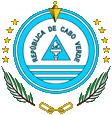 |
seit/since 1992, Wappen der Kapverden – coat of arms of Cape Verde Quelle/Source, nach by: Wikipedia (D) |
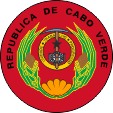 |
1974–1992, Wappen der Kapverden – coat of arms of Cape Verde Quelle/Source: Corel Draw 4 |
 |
1935–1975, Wappen der Kapverden – coat of arms of Cape Verde Quelle/Source, nach/by: Wikipedia (D) |
Bedeutung/Ursprung des Wappens – Meaning/Origin of the Coat of Arms: |
|
| Das Wappen der Kapverden, welches anlässlich der Unabhängigkeit am 05.07.1975 angenommen wurde, zeigte eine rote Scheibe, auf ihr links und rechts je eine Maispflanze, unterhalb eine Jakobsmuschel. In der Mitte ein goldener Kreis mit einer Hacke, einem Zahnrad, einem aufgeschlagenen Buch und dem schwarzen Stern, dem Leitstern der afrikanischen Freiheit. Der Mais stand für das wichtigste Agrarprodukt des Landes, und sollte die Bedeutung der Landwirtschaft unterstreichen. Die Jakobsmuschel stand für die Bedeutung des Meeres für die Inseln, hatte aber auch einen christlichen Hintergrund. Die Hacke stand für die Bauern, das Zahnrad für die Arbeiter und das Buch für die Intellektuellen. In dem goldenen Kreis das damalige Motto des Landes in portugiesischer Sprache: "Unidade, Trabalho, Progresso" → "Einheit, Arbeit, Fortschritt" | The coat
of arms of the Cape Verde Islands, which was adoped on the 5th of July in
1975 on the occasion of the independence, showed a red disk, on it, to the
left and on the right, per one corn plant, below a Jakob's Conch. In the
middle a golden circle with an hoe, a cogwheel, an opened book and the Black
Star, the lodestar of the African freedom. The corn stood for the most important agrarian product of the country, and should emphasize the importance of the agriculture. The Jakob's Conch stood for the meaning of the ocean for the islands, but had even an christian background. The hoe stood for the farmers, the cogwheel for the workers and the book for the intellectuals. In the golden circle the then motto of the country in Portugese language: "Unidade, Trabalho, Progresso" → "Unity, Work, Progress" |
| Im Zuge
der allmählichen Demokratisierung wurde am 25.09.1992 neben einer neuen
Staatsflagge auch ein neues Wappen angenommen. Es zeigt einen hellblauen
Kreis, im unteren Teil ergänzt durch drei hellblaue horizontale Streifen. In der Mitte des Kreises ein gleichschenkliges hellblaues Dreieck (Symbol der Gleichheit) mit einer silbernen Fackel (Symbol der Freiheit), umgeben vom Namen des Staates in portugiesischer Sprache. Ganz oben ein Lot (Symbol für die Gerechtigkeit), links und rechts insgesamt zehn goldene Sterne (die einzelnen Inseln der Kapverden), und unterhalb zwei Palmwedel (Siegeszeichen) und drei Kettenglieder (Symbole des Zusammenhalts). |
With the
gradual democratization was on the 25th of September in 1992 adoped – in
addition to a new flag for the country – as well a new coat of arms. It
shows a pale blue circle, in the lower part added by three pale blue
horizontal stripes. In the middle of the circle a isosceles pale blue triangle (symbol of equality) with a silvery torch (symbol of freedom), surrounded by the name of the state in Portugese language. Quite above a lead weight (symbol of the justice), to the left and on the right in total ten golden stars (the single islands of the Cape Verde Islands), and below two palm fronds (sign of victory) and three chain links (symbols of cohesiveness). |
| Im Jahre 1935 wurden für die portugiesischen Kolonien eigene Wappen eingeführt. Die Gestaltung unterlag einem gewissen Schema und so zeigte jedes Wappen neben einer lokalen Symbolik die fünf Quinas aus dem Wappen von Portugal und fünf grüne Wellen auf Silber. Als lokale Symbolik erschien im Wappen der Kapverden eine Karavelle. | In the year 1935 own coats of arms were created for the Portuguese colonies. The design was subject to a special scheme. So each coat of arms contained, in addition to a local symbolism, the five Quinas from the coat of arms of Portugal and five green waves on silver. As the local symbolism in the coat of arms of Cape Verde appeared a caravel. |
| Quelle/Source: Nationalflaggen der Welt, Flaggen Wappen Hymnen, Die Welt der Flaggen, Volker Preuß | |
Landkarten – Maps: |
Lage – Position: |
Landkarte des Landes – Map of the Country: |
Zahlen und Fakten – Numbers and Facts: |
|
|
|
|
|
|
|
|
|
|
|
|
|
|
|
|
|
|
|
| 1445 ·
Entdeckung durch den Portugiesen Diego Gomes 1460 · Besiedlung der Inseln 1495 · die Kapverden werden portugiesische Kolonie 1585 · der englische Pirat Francis Drake plündert die Hafenstadt Ribeira Grande 1592 · der englische Pirat Francis Drake plündert die Hafenstadt Ribeira Grande erneut 1876 · Verbot des Sklavenhandels 1951 · die Inseln erhalten den Status einer portugiesischen überseeischen Provinz 1961 · Gründung der PAIGCV-Partei, Beginn des Kampfes um die Unabhängigkeit von Kapverden und Guinea-Bissau 10.09.1974 · Guinea-Bissau wird unabhängig 05.07.1975 · Portugal gewährt den Kapverden die Unabhängigkeit 1981 · neue Verfassung, endgültige Trennung von Guinea-Bissau 1990 · Einführung des Mehrparteiensystems |
| 1445 ·
discovery by the Portugese Diego Gomes 1460 · settlement of the islands 1495 · the Cape Verde Islands become Portugese colony 1585 · the English pirate Francis Drake plunders the harbor Ribeira Grande 1592 · the English pirate Francis Drake plunders the harbor Ribeira Grande again 1876 · interdiction of the slave trading 1951 · the island get the status of a Portugese overseas province 1961 · foundation of the PAIGCV-party, beginning of the struggle for the independence of the Cape Verde Islands and Guinea Bissau 10th of September 1974 · Guinea Bissau becomes independent 5th of July 1975 · Portugal grants Cape Verde independence 1981 · new constitution, irrevocable separation from Guinea Bissau 1990 · introduction of the multi-parties-system |
| Quelle/Source: Atlas zur Geschichte, Discovery '97, Weltgeschichte, Wikipedia (D) |
Ursprung des Landesnamens – Origin of the Country's Name: |
|
| Der Name des Landes leites sich vom Cap Vert her ("Grünes Kap"), was die westlichste Landspitze des afrikanischen Kontinents ist. Die Inselgruppe der Kapverden selbst liegt noch einmal ca. 600 km in westlicher Richtung im Atlantischen Ozean. | The name of the
country derives from Cap Vert ( "Green Cape "), which is the westernmost
headland of the African continent. The archipelago of the Cape Verde itself
is once again about 600 km west in the Atlantic Ocean. |
| Quelle/Source: Volker Preuß | |